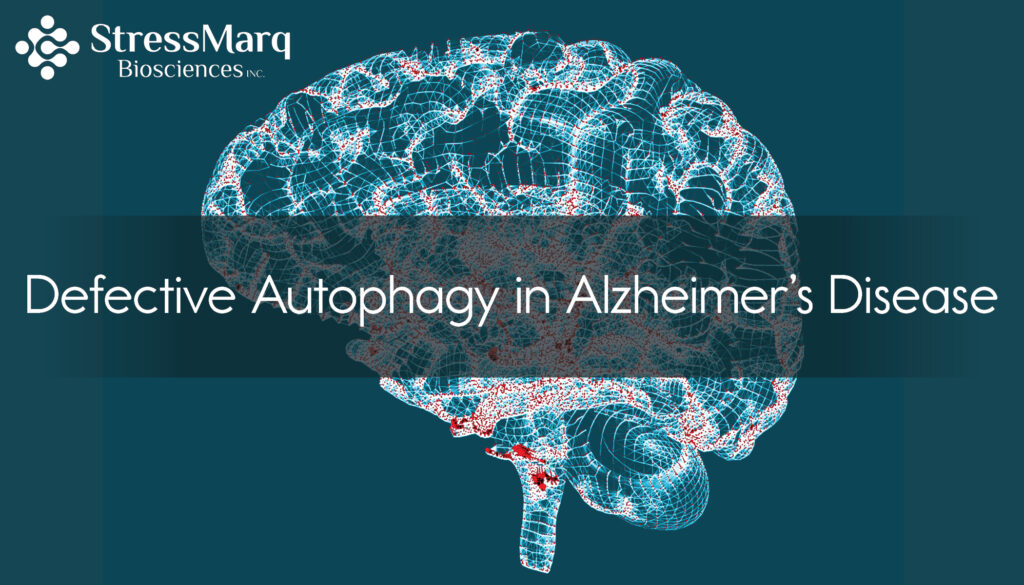Defective Autophagy in Alzheimer’s Disease
Alzheimer’s disease (AD) is a debilitating condition characterized by the gradual and progressive loss of memory and coordination. A neuropathological hallmark of AD is neurofibrillary tangles (NFTs). Here, microtubule-associated protein tau (MAPT), also known as tau pre-formed fibrils (PFFs), becomes abnormally phosphorylated and forms insoluble NFTs, which cause neuronal dysfunction.
To maintain healthy neurons, clearance of MAPT via autophagy processes is essential in breaking down macromolecules using lysosomes. In AD, defective autophagy is considered to result in the buildup of NFTs.
Cells “quality-check” substrates sent for degradation by autophagy by using selective autophagy receptors, which bind to proteins and target them to autophagy vesicular structures. MAPT binds to autophagy receptors NBR1 and SQSTM1, and the cochaperone, BAG3, can regulate this process. Until now, the mechanisms underlying these interactions have not been understood.
A study from the University of Rochester characterizes how NBR1 or SQSTM1 have distinct roles in binding to different MAPT protein species. The study also shows that BAG3 acts as a judge presiding over MAPT’s protein interactions and, ultimately, MAPT proteostasis1. The research findings uncover potential therapeutic targets for AD.
BAG3 modulates the selective binding of NBR1 and SQSTM1 to MAPT
As primary neurons maintain the characteristics of their original tissue, the researchers used rat cortical neurons to understand the role of the autophagy receptors, NBR1 and SQSTM1, in MAPT clearance. Employing short hairpin-mediated gene silencing showed that NBR1 or SQSTM1 have different functions. Depletion of NBR1, unlike SQSTM1 depletion, significantly increased phosphorylated MAPT levels.
These autophagy receptors, NBR1 and SQSTM1, colocalized with BAG3 in the different areas of the brain in control mice. Immunoprecipitation experiments revealed that BAG3 had a differential effect on MAPT’s endogenous protein interactions. NBR1 was only associated with MAPT in the presence of BAG3. While SQSTM1 was associated with MAPT only in the absence of BAG3, the presence of BAG3 disrupted the interaction.
Pull-down assays with purified proteins confirmed that NBR1 and SQSTM1 interacted directly with BAG3. The authors then questioned whether BAG3 could modulate the interactions of NBR1 and SQSTM1 with MAPT. The MAPT (Tau) used for this study was StressMarq’s Tau-441 (2N4R) Pre-formed Fibrils (catalog #SPR-480). The authors demonstrated that NBR1 binds to monomeric forms of MAPT, and SQSTM1 binds to oligomeric MAPT. The cochaperone BAG3 can regulate the specificity of these interactions.
Physiological absence of BAG3 increased phosphorylated and oligomeric MAPT
The physiological relevance of the modulatory role of BAG3 on the autophagy receptors and MAPT was studied using a BAG3 conditional knockout mouse model. SQSTM1 and NBR1 protein levels were comparable in conditional knockout and control mice. Removal of BAG3 from neural cells prevented NBR1 from interacting with phosphorylated MAPT, leading to increased levels of phosphorylated and oligomeric MAPT.
A significant decrease in colocalization between BAG3 and NBR1 was also seen when analyzing brain tissue from patients diagnosed with AD compared to the control group. The study authors speculated that in addition to autophagy clearance of MAPT, BAG3 may use another protein degradation pathway, the ESCRT pathway. NBR1-MAPT may be cleared using this pathway.
StressMarq’s products uncover the mechanisms underlying autophagy receptors and MAPT
The study by Lin et al., uncovers how the cochaperone, BAG3, dictates the binding of MAPT species to the autophagy receptors NBR1 and SQSTM1. BAG3 may be involved in distinct protein degradation pathways for each autophagy receptor. Understanding the clearance of MAPT may reveal potential therapeutic targets for AD.
Related StressMarq Products
StressMarq manufactures a range of reagents for neuroscience research. StressMarq’s anti SQSTM1 antibody (catalog# SPC-636) detects the autophagy receptor, SQSTM1, in western blot, immunocytochemistry, and immunofluorescence applications. StressMarq also sells a range of fibrillar and oligomeric protein constructs including Amyloid Beta, Alpha Synuclein and other forms of Tau (MAPT) to elucidate the molecular mechanisms underlying neurodegenerative diseases.
References
- BAG3 regulates the specificity of the recognition of specific MAPT species by NBR1 and SQSTM1. Lin, H. et al. bioRXiv preprint (2023) (note: this article is a preprint and has not been certified by peer review)


Leave a Reply